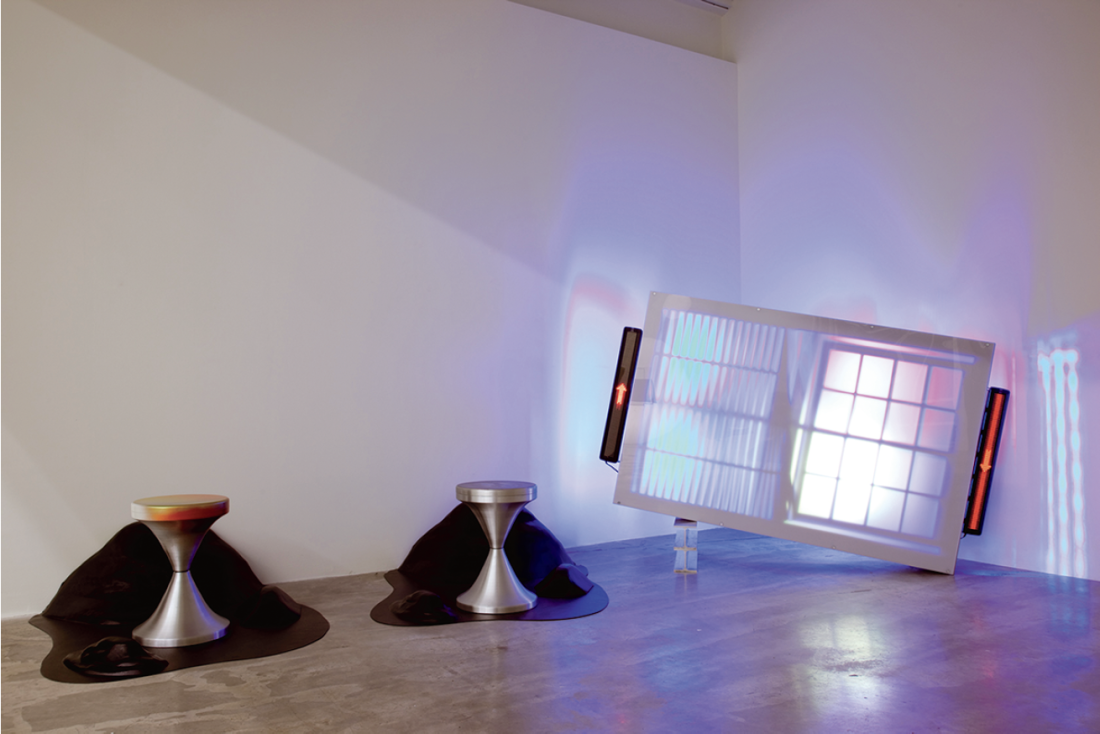Robert Youds
A year and a half ago when reviewing Robert Youds’s retrospective at the Art Gallery of Greater Victoria, “beautifulbeautiful artificial field,” a phrase popped into my head: “commercial commons.” I found myself comparing the tug-of-war within the work’s aura of commodity and possibility to the liminal drift you are prone to while loitering in airport kiosks and shopping malls … the sense of free-floating leisure that sometimes emerges in a way that feels parasitic to your intended timeline. These “temporary autonomous zones” (to borrow Hakim Bey’s phrase) are blind spots in an age of self-imposed surveillance in which the search for an authentic sense of the present amounts to a creative act.
Originally a painter, Youds identifies his work as “structures”; his material vocabulary resides in the designed environment, including Plexiglas, fabric, foam, LED and enamel-coated aluminum. The resulting work, while clearly not painting as such, invokes painting’s effects, if not its means. It might be accurate to say that Youds makes specific objects that are best discussed within criteria of perception, projection and transport, all the more freshly mobilized for not displaying obvious debts to the matter of painting. In trying to locate the in-between-ness of Youds’s work (between painting and sculpture, domestic and public, manufactured and tinkered-with), I’m reminded of a phrase the late David Foster Wallace once used to describe his writing: neither self-reflexive “metafiction” nor minimalist realism but “meta-the-distance-between the two.”

Robert Youds, For Everyone a Window, 2009, aluminum I-beam, lexan, LEDs and controller, aluminum panels, digital sign boards, 40 x 60 x 6.5”. Photo: Jesse Boles. Courtesy Diaz Contemporary, Toronto.
The foam structure Youds calls Jesus Green Tofino Sunset leaned casually against a wall at Diaz Contemporary Art in a recent exhibition. Propped up and plugged in, its gentle oscillation of coloured bands gradually initiates viewers into a feedback loop; sensation and after-image become casually haptic. The overall installation resembled a staging ground, open to intervention from the outside world. The real Jesus Green is itself an anomalous commons at Cambridge University (one field guide has it as “a quiet retreat to roll up a reflective spliff.”) Adjacent to the larger Midsummer Common, it was originally intended to be a railway station, featuring a line of picturesque plane trees, but also an anachronistic specimen of open-air swimming pool called a lido.
The marginal utopia embodied by the lido is cited here because much has been made of Youds’s uses of luminosity as a linkage to a Romantic heritage of ravishing lyricism. I think this interpretation misses the point. Despite the impressive “finish fetish” of his structures, Youds maintains an intimist’s economy; his wall pieces address a single viewer. There is something catalytic in the baffled frontality of his presentations. Like academic landscape’s Cartesian metaphors of chamber and window, the framing devices and concurrent shadows of the series entitled “X,Y,Z,A,B” suggest an ethical dimension in their conspicuous contingency. Here the event is the viewer’s immanent sense of restraint as it gradually recapitulates and dissolves the pretence of the scene.

Robert Youds, last time we stayed/TIME MUST HAVE A STOP, 2009, aluminum, enamel paint, clear coat, Plexiglas, spun aluminum stool and aluminum chain, variable dimensions. Photo: Jesse Boles. Courtesy Diaz Contemporary, Toronto.
The real test of the exhibition may be embodied in the seven spun-aluminum stools collectively titled Verner Panton’s very best day. With their hand-painted tops and dedicated plastic mats, the stools resemble a kind of votive stand-in for a viewer’s investment, both offering and ashtray. Their narrative titling, recalling the Danish designer’s immersive, chromatic interiors, suggests stakeholders in a failed—or fantastic—seriousness. There is an urbane irony here, a flattening out of possibilities. It is an important part of Youds’s operation, projecting the shallow, cubist backspace of his structures into reverie’s narrative theatres.
This can be evidenced in For Everyone a Window, which takes the viewer through a six-minute cycle of shifting colour and time sequences that suggests a much longer duration. This mnemonic lapse had both temporal and spatial dimensions for me, a few moments drawn out into the eternal wait separating Jay Gatsby’s lookout from Daisy’s green beacon. By now, the collegiate connotations of that romantic story have doubtlessly become personally both more poignant and less useful than they once were, acquiring a polish of irony that does not diminish their currency but preserves it at a wishful distance. Youds’s angling play of coloured light feels a little like those shafts beaming down on the verging words of an Ed Ruscha drawing. Being both artificial and affecting, they announce a moment that is already over with, vacant, but in the light of attention, cool and trucial. ❚
“Robert Youds: Jesus Green Tofino Sunset” was exhibited at Diaz Contemporary in Toronto from May 14 to June 20, 2009.
John Luna is a painter, critic and teacher who lives in Victoria, BC.

